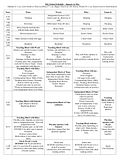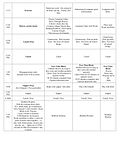Oh, alright, that helps! Thanks for getting back to me, Stawna!

HOD guides can be used to combine, or they can be used to teach dc separately. We always take care to try to help each family with placement, individually looking at each child to see whether combining is a good fit for the entire family.

Meeting each of our dc's needs and having age appropriate expectations really makes the day so much easier than grouping them all together if they’re nowhere near each other in what they need and what they can do.

HOD was written with multiple ages in mind, so combining can be very successful within those age ranges, as long as dc can do the work that is asked of them. The placement chart helps us as parents consider each of our dc and place them accurately for the year. It helps make clear if combining is a positive for all the dc involved or not.

I have personally relied on the placement chart to place each of my dc, and the result has been dc thriving in school, loving it, and able to do everything asked of them in their day. No tweaking is necessary because they are placed in programs befitting their needs.

This is such a relief to me!
You probably have noticed when you come to the HOD Board, we take care to ask about each of your dc's specific needs when considering proper placement. That is because we care deeply about each of your dc, just as we care deeply about each of our dc.

You mentioned that on another board, someone said you could just put your dc 3 grades apart together for school. This is possible with HOD, as long as it’s a good fit for each child being combined. For example, a 7 yo and an 11 yo may be doing Bigger Hearts for His Glory together, with the 11 yo using extensions. This works great, as long as each child is appropriately placed!

When you received advice on another board that your 2 dc 3 grades apart could easily be combined, I'm wondering whether they asked about each of your dc, and what they individually need before offering placement advice? Did they ask if your children can read or write? And if so, did they ask at what levels each are able to read and write? Or about their grammar or math levels? Or if they can read their history or science? Or if they have narration, dictation, and copywork skills intact? Or what skills they have to work somewhat independently and follow directions? Or if they have personality conflicts with one another? Or health issues? Or learning disabilities? Or anything? Or was a common statement just made that you can easily combine your dc 3 grades apart with no personal consideration of each of their needs?
I ask you these questions not expecting you to answer them all

, but to try to show that all of these things are very important skills to consider in placement for each child, which is why we ask about these things here before offering placement advice. If these questions don't need to be asked in order to use a curriculum, then how can dc be placed accurately for their individual needs? According to CM children aged 9 yo or older, should be reading their own history, science, etc. This is a staple of CM style learning. At HOD we embrace that thinking, so based on that thinking if there is no need to ask what each of your dc are able to read, then how can a person know where to place the children?
One may say, "Well, I'll just read everything aloud to my 9+ yo, and then the youngers can just listen in". Reading aloud all subject areas to dc so large ages can be combined results in older dc not taking on responsibility for their own reading of subject matters. Often times, more mature content is chosen to compensate for this, so that a parent reading aloud more difficult books with very mature content will then help the oldest be challenged enough. In this case it's important to recognize that "listening" to read alouds is a lower level skill than "reading" the material oneself, so choosing more difficult books to read aloud only results in older dc still just being the listeners, and younger dc hearing inappropriate content. It also takes much more time to read books aloud than it takes to read books independently silently, so school for the littles often goes far too long, drawing their day out. This is just one example of how grouping large age ranges together often leaves littles trailing behind, and olders inappropriately challenged, as they are still not reading their own books.

We strive to guard against the youngest child "trailing along" behind the oldest dc. "Trailing along" year after year often turns into dc being "left behind", and at that point, the youngest child is truly struggling, often unable to do what the oldest child was able to do at their same age, as they did not receive the same teaching instruction appropriate for their young age level as their older sibling did back when. Skills often don't teach themselves, and if dc are moved along year to year without learning age appropriate skills, they must go back, back, back... and learn many of them at some point. It is often hard to make up time this way. This is why when HOD combines dc, it is in smaller age increments, with the core of the program fitting the younger and the extensions fitting the olders.

We want every child to be successful in their homeschooling, and we want every child to be able to move along in their academic and spiritual learning each year step by step in a way that is purposeful for each of them. When dc are many grades apart, combining is usually not as feasible as someone's needs do not get met. Usually it is the younger child that gets lost in the shuffle, while the older child continues to move on.

All ages simply do not have the same academic needs. HOD considers all dc's academic needs, and in doing so values each family member, which helps family learning be a positive for everyone! So when you are told that your dc 3 grades apart can easily be combined with little to no information about each of your dc being considered, be careful about accepting that placement as best for your entire family. This is a whole year of your life - it's important to think of each child so each child can soar!
So, on that note, for your dd, I think she sounds ready for Beyond Little Hearts!

For your ds, I think you need to take the age factor out of placement, and look carefully at the first page of the placement chart with just him (not dd) in mind. Here's an idea... Could you print a copy of the first page of the placement chart, and circle where he falls in the columns? Then, can you share where he places individually, and give some details about what you circled? Next, could you print the first week of plans for the guide he placed in, and read through the plans and see how you think he'd do? If the reading or writing is going to be too much for a student, and you are thinking tweaking will be necessary, then you may want to consider an earlier guide. I would love to hear the results you come up with by doing these few little things! It has been very helpful for me to clear my mind and think of just one child of mine at a time when I look at the placement chart. I have so much more clarity in placement then, as opposed to just looking at the chart for everyone all at once. I know this seems to be a small thing, but really, I do think it makes a huge difference! If you get a chance to share what you find out, that would help me feel more confident about giving advice.

As he just turned 9 yo, it could be possible the 2 of them could be combined in Beyond Little Hearts, with ds using the right side of Bigger Hearts for his LA and math. Or, it may be best if he does Bigger Hearts or PHFHG. If you get a chance to share what you find out after filling out the placement chart with just him in mind, then I'd be glad to talk through options that are customized to your family's needs as we consider each of your dc!

In Christ,
Julie

